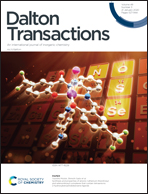Adjustable uniaxial zero thermal expansion and zero linear compressibility in unique hybrid semiconductors: the role of the organic chain†
Abstract
Zero thermal expansion (ZTE) and zero linear compressibility (ZLC) are unique and rare properties. Materials combining ZTE and ZLC will have promising prospects. A novel route is proposed in this work to design the coexistence of uniaxial-ZTE and ZLC based on layered hybrid semiconductors [ZnTe(L)0.5] [L = N2H4, ethylenediamine (en), propyldiamine (pda)]. In the framework of [ZnTe(L)0.5], the organic chain contains the attractive and repulsive interactions that arise from the different organic components. It is demonstrated that changing the length of the organic chain can effectively regulate the interaction between different organic components and then achieve the uniaxial-ZTE and ZLC or the desired thermal expansion and compression behaviors. The origin of the coexistence of abnormal axial responses has been traced from thermodynamic formalisms, model Grüneisen parameters and specific vibration modes. It is found that low-energy phonons play an important internal role in realizing the multi-peculiar properties.



 Please wait while we load your content...
Please wait while we load your content...